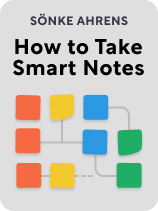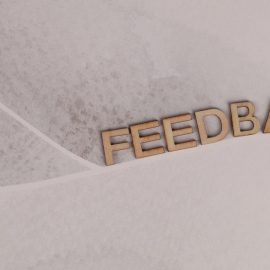

This article is an excerpt from the Shortform book guide to "How to Take Smart Notes" by Sönke Ahrens. Shortform has the world's best summaries and analyses of books you should be reading.
Like this article? Sign up for a free trial here .
What is the Zettelkasten method of note-taking? How does Zettelkasten compare to the traditional methods of note-taking?
An important part of your education or your job might be taking notes. The Zettelkasten method can not only help you remember important ideas but also helps you to organize your notes to move your research forward.
In this article, we’ll dive into five specific features of the slip-box system that make it superior to traditional methods.
#1: The Zettelkasten System Requires You to Write at Every Stage of the Creative Process
The Zettelkasten method of note-taking encourages you to write anywhere at any time. People who use the traditional note-taking process are intimidated by the blank screen because that’s the first time they think critically about their argument. Traditional note-taking methods focus on capturing others’ ideas instead of thinking extensively about them. So even if you’ve taken lots of notes by the time you sit down to write, you still haven’t thought about or developed your argument. You only do that when you sit in front of your blank screen—and that’s what intimidates you, not the writing itself.
(Shortform note: As one writer points out, the blank screen may also terrify you because you’re afraid your writing will be terrible—in other words, that you’ll fail. However, in The Magic of Thinking Big, David J. Schwartz contends that you can destroy this fear by acting—in other words, by writing anyway.)
In contrast, Ahrens argues that by making you write at every stage, the Zettelkasten system moves this thinking work far earlier in the process—so by the time you face the blank screen, you’ve already thought extensively about what you’re going to say and no longer feel intimidated by it.
#2: The Zettelkasten Method Follows a Bottom-Up Approach
Ahrens contends that most writers use a top-down method when working with their manuscripts. Normally, you read a little, come up with an original thesis, do further research on your thesis, then write your paper. In other words, you create ideas to support your existing thesis rather than developing a thesis that encompasses your original ideas.
(Shortform note: The top-down method that Ahrens contends most writers use may be culturally influenced. In The Culture Map, cultural communications expert Erin Meyer explains that some Western cultures think theoretically, or top-down: They’ll first formulate a general hypothesis from which they deduce a conclusion. Writers in these cultures might be more prone to the top-down approach Ahrens advises against than writers from cultures that encourage looking at the data first before concluding.)
This top-down method works in theory. But in practice, Ahrens argues, it has three main issues—all of which you can avoid by using the bottom-up approach of the Zettelkasten system:
- You’ll struggle to find source material
- You’ll fall victim to confirmation bias
- You’ll grow bored with your work.
#3: The Zettelkasten System Breaks Down Your Writing Workflow
Another reason the Zettelkasten note-taking method is superior is that it improves your overall workflow. Ahrens contends that traditionally, people collect a mishmash of reading and note-taking methods to help with their writing. But since these tools are designed to improve one step of the writing process and not the overall workflow, they slow you down. For example, you might use highlighting as a method to mark a useful idea in a book—but without a reference management method, you won’t be able to remember where that idea is in the book when you want to use it in your paper.
In contrast, Ahrens notes, the Zettelkasten method breaks down your entire writing workflow, from researching to writing a paper, into the clear, logical steps we discussed previously. Since you use only one system throughout, using it speeds up your writing process. For example, you never have to remember where you highlighted an idea; you just review your literature notes.
#4: The Zettelkasten System Provides Regular Feedback
Ahrens argues that another benefit of breaking down your writing workflow is that doing so provides regular feedback. Ahrens contends that in traditional academic writing methods, you don’t gain regular feedback. For example, you might jot down an idea you’ve learned from a book—but you don’t learn whether it’s useful until you try to include it in your paper several steps later.
In contrast, Ahrens argues that when you use the zettelkasten system, you gain regular, immediate feedback at each stage of the process. For example, by filing evergreen notes in your slip-box, you immediately learn whether a note is valuable: A note you can logically file behind another note and that connects to several other notes within the zettelkasten is probably a better idea than a note you find only a few connections to.
#5: The Zettelkasten Method of Note-Taking Mimics Your Brain
Ahrens contends that the Zettelkasten note-taking method fosters creative insights by mimicking how your brain works. Ahrens explains that learning in the brain involves connecting new information to information you already know.
In contrast, creativity involves connecting various pieces of information in original ways. Ahrens adds that most creative insights result from thinking a lot about a particular topic, then connecting those ideas to something new in an original way.
How does using the Zettelkasten system mimic this structure? As Ahrens notes, the process of filing your notes in the Zettelkasten encourages both learning and creativity. You must think deeply about how your note connects to other notes in standard ways, which fosters learning, and in unique ways, which fosters creativity.

———End of Preview———
Like what you just read? Read the rest of the world's best book summary and analysis of Sönke Ahrens's "How to Take Smart Notes" at Shortform .
Here's what you'll find in our full How to Take Smart Notes summary :
- Why traditional, prewriting note-taking methods don’t work
- How to use the slip-box system method of note-taking
- How to organize and file your notes






